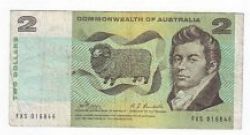
Macarthur Merinos

$2 banknote
Australia's first $2 banknote featured John MacarthurWhen John Macarthur was in England in 1801 to face a Court Martial he promoted the colonial wool industry to the British government and returned in 1805 with a commission from Lord Camden to develop the industry in New South Wales. He had already run sheep on Elizabeth Farm at Parramatta and on his land at Seven Hills. He chose land at the Cowpastures in 1805, which he called 'Camden' and later 'Camden Park’.
John Macarthur first sent a sample of wool to England in 1808 and wool production became the mainstay of the Camden estate. While he was exiled in England from 1809 to 1817 his wife Elizabeth took control of sheep breeding.
John Macarthur was not the first to breed or grow sheep in Australia but he was one of the first to export quality wool in commercial quantities. In 1822 they exported 7,000kg of wool to England.
A major problem was that the sheep got dirty in the dry summer months and this reduced the value of their wool. To avoid this problem, it became usual practice in the colony to wash sheep before shearing.
Camden's sheep-washing site is shown on early maps – it was on the Nepean River at Belgenny.
After the sheep were washed they were shorn, often by convicts, using blade shears. It was a process that required considerable skill to remove the wool without damaging it or the sheep.
Wool production declined at Camden in the 1840s and the flock was moved to better sheep country on the family property 'Richlands' near Taralga. Later part of the flock was moved to Victoria under the ownership of William Campbell. There the breed was kept pure and in 1880 part of the flock was returned to Camden.
The Merino sheep that you see on Belgenny Farm today are descended from those animals.
John and Elizabeth Macarthur are widely recognised for their role in developing Australia's merino sheep and wool industry. It is also important to recognise the roles played by John and Elizabeth’s sons James, William, John and Edward.


